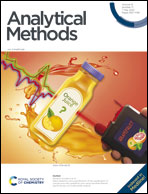Smartphone-based fluorescence detection of bilirubin using yellow emissive carbon dots†
Abstract
Development of highly sensitive and selective fluorescent probes for biomolecule detection has significant implications in clinical diagnosis and bioanalysis. In this study, yellow emissive carbon dots (Y-CDs, λex 430 nm, λem 550 nm) are synthesized utilizing a one-pot solvothermal approach with o-phenylenediamine (oPDA) as a precursor. The fluorescence of Y-CDs was quenched with the addition of bilirubin due to the inner filter effect mechanism. The fluorescence intensity of Y-CDs decreases as bilirubin concentration increases and can be completely quenched with approximately 90 μM bilirubin. Over other coexisting interferents (26 interferents), the Y-CD probe exhibited great selectivity for bilirubin. More crucially, a smartphone can capture the visible color intensity change of the Y-CD probe under a 365 nm UV lamp and later with the aid of computer software, RGB (red/green/blue) analysis was performed for the quantification of colors. This provides computer vision-based detection and sensitive bilirubin assay with a linear range of 4.0–225 μM and a limit of detection of 1.37 μM. Furthermore, the proposed fluorescent probe was applied in real samples (newborn serum, serum and urine of adults with hyperbilirubinemia) with satisfactory recoveries (96–102%). Based on the validation findings, solution and computer vision-based methods have the potential to be used as fast detection methods for bilirubin in biological samples at the bedside. For the first time, a fluorescent probe based on yellow emissive CDs and RGB analysis for bilirubin recognition has been reported.



 Please wait while we load your content...
Please wait while we load your content...